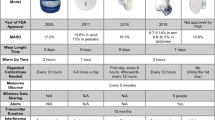Abstract
This paper describes the design of an implantable system for velocity-selective electroneurogram (ENG) recording. The system, which relies on the availability of multielectrode nerve cuffs (MECs) consists of two CMOS ASICs. One ASIC called the electrode unit (EU) is a mixed analogue/digital signal acquisition system which is mounted directly on an MEC in order to optimize the interface between the two. It is linked to the other ASIC by means of a 5-core cable through which it receives power and commands in addition to transmitting data. The second ASIC, called the monitoring unit (MU) manages the interface between the EUs (each MU can control up to three EUs) and an RF transcutaneous link to the external signal processor. The ASICs are fabricated in 0.8 μm CMOS technology. The EUs measure 3 mm × 4 mm each and consume 105 mW (35 mW each), while the MU measures 1.5 mm × 2 mm and consumes 4 mW. The power consumption on the communication channels (including cable losses) between the MU and EUs is 129 mW. A digital communication strategy between the two parts of the implanted system and the external controller is described.
















Similar content being viewed by others
References
Brindley, G. S. & Rushton, D. N. (eds.). (1995). Clinical neurology: Neuroprostheses (vol. 14, no. 1). London: Baillieres-Tindall.
Schmidt, R. A., Bruschini, H., & Tanagho, E. A. (1978). Feasibility of inducing micturition through chronic stimulation of sacral roots. Urology, 12, 471–477.
Haugland, M. K., & Hoffer, J. A. (1994). Artifact-free sensory nerve signals obtained from cuff electrodes during functional electrical stimulation of nearby muscles. IEEE Transactions on Rehabilitation Engineering, 2, 37–40.
Haugland, M. K., & Hoffer, J. A. (1994). Slip information obtained from the cutaneous electroneurogram: Application in closed loop control of functional electrical stimulation. IEEE Transactions on Rehabilitation Engineering, 2, 29–36.
Haugland, M. K., Hoffer, J. A., & Sinkjaer, T. (1994). Skin contact force information in sensory nerve signals recorded by implanted cuff electrodes. IEEE Transactions on Rehabilitation Engineering, 2, 18–28.
Haugland, M., Lickel, A., Haase, J., & Sinkjaer, T. (1999). Control of FES thumb force using slip information obtained from the cutaneous electroneurogram in quadriplegic man. IEEE Transactions on Rehabilitation Engineering, 7(2), 215–227
Strange, K. D., & Hoffer, J. A. (1999). Gait phase information provided by sensory nerve activity during walking: Applicability as a state controller feedback for FES. IEEE Transactions on Biomedical Engineering, 46(7), 797–810.
Waters, R. L., McNeal, D. R., Faloon, W., & Clifford, B. (1985). Functional electrical stimulation of the peroneal nerve for hemiplegia: Long term clinical follow-up. The Journal of Bone and Joint Surgery, 67A, 792–793.
Haugland, M. K., & Sinkjaer, T. (1995). Cutaneous whole nerve recordings used for correction of footdrop in hemiplegic man. IEEE Transactions on Rehabilitation Engineering, 3, 307–317.
Steyaert, M., Sansen, W., & Zhongyuan, C. (1987). A Micropower Low-Noise Monolithic Instrumentation Amplifier for Medical Purposes. IEEE Journal of Solid-State Circuits, SC-22(6), 1163–1168.
Martins, R., Selberherr, S., & Vaz, F. A. (1998). A CMOS IC for portable EEG acquisition systems. IEEE Transactions on Instrumentation and Measurement, 47(5), 1191–1196.
Ji, J., & Wise, K. D. (1992). An implantable CMOS circuit interface for multiplexed microelectrode recording arrays. IEEE Journal of Solid-State Circuits, 27(3), 433–443.
Perelman, Y., & Ginosar, R. (2006). An integrated system for multichannel neuronal recording with spike/LFP separation and digital output. Proceedings of the 2nd International IEEE IEMBS Conference on Neural Engineering. Arlington, Virginia.
Rieger, R., Taylor, J., Demosthenous, A., Donaldson, N., & Langlois, P. (2003). Design of a Low-Noise Preamplifier for Nerve Cuff Electrode Recording. IEEE Journal of Solid-State Circuits, 38(8), 1373–1379.
Pflaum, C., Riso, R. R., & Wiesspeiner, G. (1996). Performance of alternative amplifier configurations for tripolar nerve cuff recorded ENG. Proceedings of the IEEE International Conference Engineering and Medcine and Biology Society (EMBS) (vol. 1, pp. 375–376). Amsterdam, Netherlands.
Rushton, W. A. H. (1951). A theory of the effects of fibre size in medullated nerves. Journal of Physiology, 115, 101–122.
Taylor, J., Donaldson, N., & Winter, J. (2004). Multiple-electrode nerve cuffs for low velocity and velocity-selective neural recording. Medical and Biological Engineering and Computing, 42, 634–643.
Stieglitz, T., Beutel, H., Schuettler, M., & Meyer, J. U. (2000). Micromachined Polyimide-Based Devices for Flexible Neural Interfaces. Biomedical Microdevices, 2(4), 283–294.
Donaldson, P. (1983). The Cooper cable: an implantable multiconductor cable for neurological prostheses. Medical and Biological Engineering and Computing, 21, 371–374.
ISO standard, ‘Information technology-Open Systems Interconnection-basic reference model: the basic model’, ISO/IEC 7498–1, 1994.
Jones, A., Uzam, M., & Ajlouni, N. (1996). Design of discrete event control systems for programmable logic controllers using T-Timed Petri Nets. Proceedings of the 1996 IEEE International Symposium on Computer-Aided Control System Design (pp. 212–217). 15–18 September, Dearborn, MI, USA.
Rieger, R., et al. (2006). Very low-noise ENG amplifier system using CMOS technology. IEEE Transactions on Neural Systems and Rehabilitation Engineering, 14(4), 427–437.
Rieger, R., Pal, D., Taylor, J., Clarke, C., Langlois, P., & Donaldson, N. (2005). 10-Channel very low-noise ENG amplifier system using CMOS technology. Proceedings of the IEEE International Symposium on Circuits and Systems (ISCAS 2005) (pp 748–751). May, Kobe, Japan.
Author information
Authors and Affiliations
Corresponding author
Rights and permissions
About this article
Cite this article
Clarke, C.T., Xu, X., Rieger, R. et al. An implanted system for multi-site nerve cuff-based ENG recording using velocity selectivity. Analog Integr Circ Sig Process 58, 91–104 (2009). https://doi.org/10.1007/s10470-008-9233-2
Received:
Revised:
Accepted:
Published:
Issue Date:
DOI: https://doi.org/10.1007/s10470-008-9233-2




